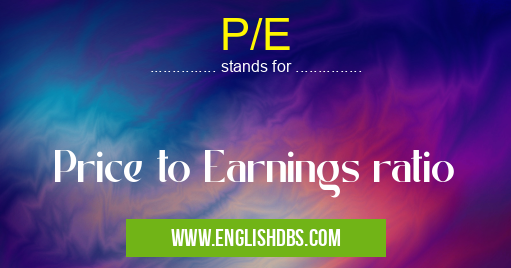What does P/E mean in ACCOUNTING
P/E stands for Price to Earnings Ratio. It is a financial indicator used to compare the relative value of a company by looking at the company's stock price compared to its earnings. P/E ratios are most commonly used to gauge how investors view a company, and it can provide clues about the underlying fundamentals of the company, as well as act as a predictor of future price movements. Understanding P/E ratios can help investors make informed decisions when investing in companies and making strategic investments.

P/E meaning in Accounting in Business
P/E mostly used in an acronym Accounting in Category Business that means Price to Earnings ratio
Shorthand: P/E,
Full Form: Price to Earnings ratio
For more information of "Price to Earnings ratio", see the section below.
» Business » Accounting
What Is P/E Ratio?
A Price-to-Earnings (P/E) ratio is simply the market price per share of a company's stock divided by its earnings per share (net income divided by total shares outstanding). The ratio measures what a buyer would pay for one unit of net income generated by that particular stock, assuming all other attributes remain constant. A higher P/E ratio means that investors are willing to pay more for each dollar earned, which generally indicates strong investor confidence in the company's future prospects. Conversely, lower ratios suggest decreased investor confidence and weaker growth prospects.
Interpretation Of P/E Ratio
The interpretation of the P/E ratio varies depending on the type of industry the company is in and its current stage in the business cycle. Generally speaking, high P/E ratios mean that investors are willing to pay more for each dollar of earnings compared to companies with lower PE ratios, implying strong investor confidence and expectations of future growth. On the other hand, low P/E ratios may reflect weak growth prospects or potential undervaluation of stocks due to current market sentiment or overall industry outlook. Ultimately when assessing whether a particular stock has an attractive valuation or not depends on context - investors should consider how it compares with other stocks within its sector, as well as taking into account general market conditions such as economic cycles or broader macroeconomic trends that might affect valuations across different industries.
Essential Questions and Answers on Price to Earnings ratio in "BUSINESS»ACCOUNTING"
In summary, Price-to-Earnings Ratios are important metrics used by investors when evaluating stocks and other investments because they provide insight into how much people are willing to pay for one unit of earnings from that particular stock. Knowing how these metrics work and interpreting them correctly allows investors to make better investment decisions based on their analysis rather than just blindly following market sentiment or relying solely on historical performance data.
